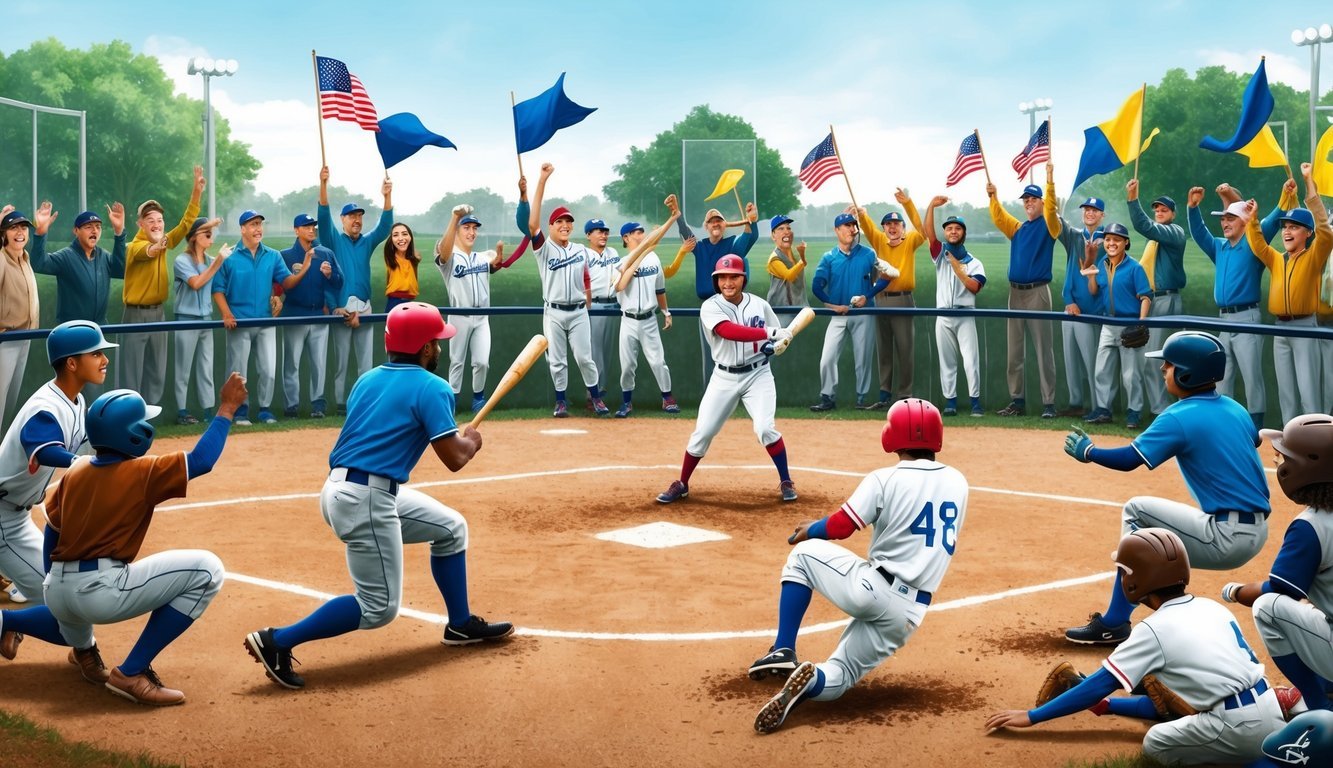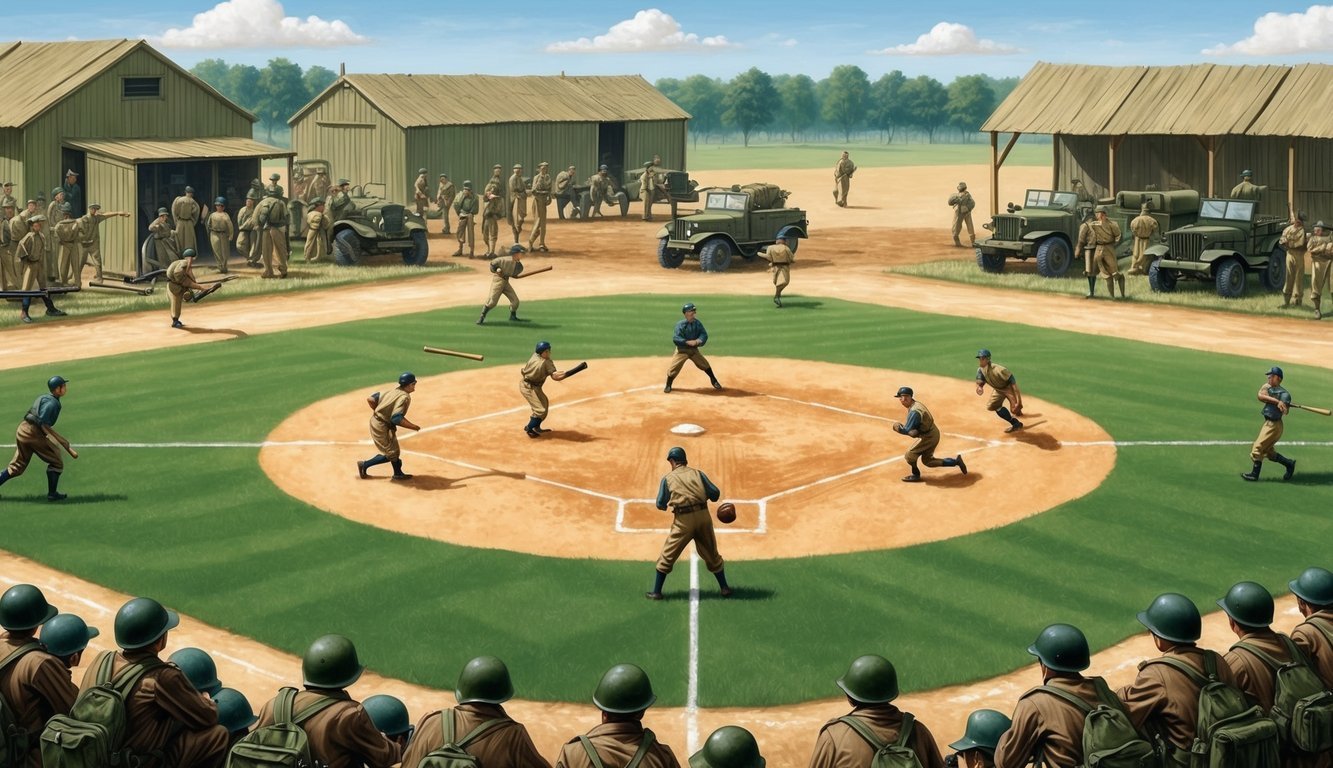Baseball played a unique and significant role during World War II, both on the home front and abroad.
As America entered the war, over 500 Major League Baseball players traded their team uniforms for military fatigues, including stars like Joe DiMaggio and Ted Williams. Despite this talent drain, baseball continued to thrive, serving as a morale booster for civilians and soldiers alike.
The sport faced challenges but adapted to wartime conditions.
Major League Baseball implemented changes to accommodate travel restrictions and material shortages.
Minor leagues saw a reduction in teams, but many continued to operate.
Baseball games became a welcome distraction for war-weary Americans, providing a sense of normalcy and entertainment during uncertain times.
On military bases and in combat zones, baseball emerged as a popular pastime for servicemen.
Impromptu games were organized wherever possible, from Pacific islands to European fields.
The sport helped maintain troop morale and fostered camaraderie among soldiers from diverse backgrounds.
Baseball’s enduring presence throughout the war years demonstrated its deep-rooted connection to American culture and resilience.
Impact of World War II on Major and Minor Leagues
World War II significantly altered the landscape of baseball in America.
The conflict affected both major and minor leagues, reshaping team rosters and league operations.
Commissioner’s Role and the ‘Green Light Letter’
Commissioner Kenesaw Mountain Landis played a crucial role during this period.
He wrote the famous ‘Green Light Letter’ to President Franklin D. Roosevelt, seeking guidance on whether baseball should continue during wartime.
Roosevelt gave his approval, believing baseball would boost morale.
This decision allowed the sport to carry on, albeit with notable changes.
The commissioner worked to balance patriotic duty with the continuity of America’s pastime.
Landis encouraged players to enlist while also implementing measures to keep the game alive on the home front.
Changes in Team Composition and Player Shortage
Over 500 major league players swapped their baseball uniforms for military attire during World War II.
This exodus of talent drastically altered team compositions.
Stars like Stan Musial, Joe DiMaggio, and Ted Williams served their country off the diamond.
The minor leagues felt the impact even more severely.
With 4,076 players entering military service, many minor league teams struggled to field competitive rosters.
Some teams even folded due to the shortage of players.
Teams got creative to fill their ranks.
They signed older players, some past their prime, and even recruited those with physical exemptions from military service.
The St. Louis Browns and Their Unique Wartime Success
The St. Louis Browns experienced an unexpected period of success during the war years.
Traditionally one of the weaker teams in the American League, they capitalized on the depleted talent pool.
In 1944, the Browns won their first and only American League pennant.
They faced their cross-town rivals, the St. Louis Cardinals, in the World Series.
Though they ultimately lost, it remains the Browns’ only World Series appearance in their St. Louis history.
The Browns’ success highlighted how the war reshaped competitive balance in baseball.
It gave smaller market teams a chance to shine as the playing field leveled due to player shortages.
Baseball Players in the Military
Many professional baseball players traded their team uniforms for military ones during World War II.
Their service impacted both their careers and the sport as a whole, while also bringing America’s pastime to soldiers abroad.
Famous Players Who Served
Ted Williams, known as “The Splendid Splinter,” served as a Navy pilot.
He missed three full seasons at the peak of his career.
Hank Greenberg was one of the first stars to enlist, serving in the Army Air Corps.
Bob Feller volunteered for the Navy immediately after Pearl Harbor.
He served on the USS Alabama and missed four seasons.
Joe DiMaggio joined the Army Air Forces in 1943, playing baseball for military teams.
Stan Musial entered the Navy in 1945, serving until 1946.
These players, along with many others, put their careers on hold to support the war effort.
Effect on Player Careers and Teams
The absence of star players had a significant impact on Major League Baseball.
Teams struggled to field competitive rosters, often relying on older players or those deemed unfit for military service.
Many players missed prime years of their careers.
For example, Williams lost nearly five seasons to military service across World War II and the Korean War.
This affected their career statistics and potentially their legacy in the sport.
Some teams were hit harder than others.
The Detroit Tigers lost Greenberg and several other key players, making it difficult to defend their 1940 World Series title.
Intramural Competition among Soldiers
Baseball thrived within military ranks during the war.
Intramural leagues formed on bases and ships, providing entertainment and boosting morale for servicemen.
G.I.s played baseball wherever they were stationed, from remote Pacific islands to European battlefronts.
These games offered a taste of home and a brief respite from the stresses of war.
The Overseas Invasion Service Expedition (OISE) All-Stars, featuring Major League players, toured military bases to entertain troops.
These exhibition games showcased top talent and helped maintain interest in the sport during wartime.
The Home Front: Baseball and American Morale

Baseball played a crucial role in maintaining American morale during World War II.
The sport provided a sense of normalcy and unity for citizens facing wartime challenges.
The Role of Baseball in Boosting Public Morale
Baseball games offered a much-needed escape from the harsh realities of war.
Fans gathered at ballparks to cheer for their favorite teams, temporarily forgetting their worries.
The familiar crack of the bat and the roar of the crowd reminded people of peacetime pleasures.
Radio broadcasts of games reached millions of listeners, including soldiers overseas.
These broadcasts strengthened the connection between troops and their loved ones back home.
Many professional players joined the military, but those who remained continued to play.
Their dedication to America’s pastime inspired fans and reinforced the nation’s resilience.
Minor Leagues and the Community
Minor league baseball thrived during the war years.
Local teams became focal points for community spirit and pride.
Small-town ballparks hosted exciting games that brought neighbors together.
These games often featured special events to support the war effort.
Fans could buy war bonds at the stadium or participate in patriotic ceremonies before the first pitch.
Minor league players, many too young or old for military service, became local heroes.
Their performances on the field gave spectators a welcome distraction from wartime hardships.
War-Related Fundraisers and Events
Baseball organizations actively supported the war effort through various initiatives.
Teams hosted “War Bond Games” where admission was paid by purchasing bonds.
These events raised millions of dollars for the war effort.
Players participated in exhibition matches at military bases, boosting troop morale.
These games gave soldiers a taste of home and a chance to see their baseball idols up close.
Benefit games for war-related charities were common.
Teams donated proceeds to organizations supporting wounded veterans or families of fallen soldiers.
These events showcased baseball’s commitment to the national cause.
Influence of World War II on Baseball’s Evolution

World War II catalyzed significant changes in baseball, reshaping the sport’s landscape and opening new opportunities.
The conflict’s impact led to groundbreaking developments that would alter the game for decades to come.
Integration and Jackie Robinson
Jackie Robinson’s historic debut with the Brooklyn Dodgers in 1947 marked a pivotal moment in baseball history.
The war played a crucial role in accelerating integration efforts.
Many Black players had served alongside white soldiers, challenging racial barriers.
As Robinson broke the color line, he not only paved the way for future athletes but also captivated the nation with his skill and perseverance.
His contributions culminated in unforgettable moments, including the first World Series highlights that showcased his talent on the grandest stage, further solidifying his legacy in the sport.
Robinson’s journey inspired many and ignited a broader movement for racial equality in America.
Robinson’s success paved the way for other talented Black players from the Negro Leagues to enter Major League Baseball.
This influx of talent enriched the sport and expanded its fanbase.
The integration process was gradual but profound.
It not only diversified team rosters but also helped shift public perceptions about racial equality in American society.
The All-American Girls Professional Baseball League
As male players joined the war effort, baseball sought new ways to maintain public interest.
Philip K. Wrigley, the chewing gum magnate and Chicago Cubs owner, founded the All-American Girls Professional Baseball League in 1943.
The league provided entertainment for war-weary Americans and showcased women’s athletic abilities.
Teams like the Rockford Peaches and Racine Belles became popular attractions.
Though the league disbanded in 1954, it left a lasting legacy.
It challenged gender norms in sports and inspired future generations of female athletes.
Wartime Innovations and Night Games
The war years saw various innovations in baseball.
Night games, introduced before the conflict, became more prevalent.
They allowed factory workers on evening shifts to attend games, boosting attendance.
Teams experimented with equipment changes due to wartime rationing.
Some used balata balls when rubber was scarce, altering gameplay dynamics.
Baseball embraced its role in supporting the war effort.
Exhibition games raised funds for military causes, while players visited hospitals and military bases to boost morale.
These adaptations demonstrated baseball’s resilience and its ability to evolve in challenging times.
Baseball Post-War: The Transition and Legacy

Baseball experienced a remarkable revival after World War II.
The sport’s resurgence was fueled by returning veterans and lasting changes from the war years.
Returning Veterans and the Sport’s Resurgence
Joe DiMaggio, Ted Williams, and Bob Feller traded their military uniforms for baseball jerseys, igniting fan excitement.
Their return symbolized America’s shift from wartime to peacetime pursuits.
Yankee Stadium and ballparks across the nation saw attendance soar.
Families embraced baseball as a wholesome entertainment, celebrating the freedoms they had fought to protect.
President Franklin Roosevelt’s “Green Light Letter” during the war had kept baseball alive.
This decision proved crucial for the sport’s post-war boom.
Influence of Wartime Changes on Post-War Baseball
The war years introduced innovations that shaped baseball’s future.
Night games, initially implemented to accommodate factory workers’ schedules, became a permanent fixture.
Women’s participation in baseball during the war opened doors.
Though the All-American Girls Professional Baseball League eventually folded, it paved the way for greater inclusion in sports.
Baseball’s global reach expanded.
American servicemen had introduced the game in the Pacific theater, planting seeds for international growth.
The sport’s role in boosting morale during the war elevated its status as America’s pastime.
Baseball emerged stronger, more popular, and more culturally significant than ever before.
